Famous Cases: Who Killed Warren Harding?
Report Number: 2381*
*As the actual file is missing, this case has been pieced together from interviews, memoirs and assorted public records.
Date: August 2, 1923
Location: San Francisco, California
Of all the American presidents who died in office, none had more
questions surrounding his demise than the 29th President, Warren
Harding. After Harding expired in San Francisco on August 2, 1923, the
cause of death was ascribed to food poisoning, a determination later
changed to stroke. However, many people suspected murder, as Harding
had his share of enemies. But the true story behind Harding's death may
have gone to the grave with one dogged FVZA Agent.
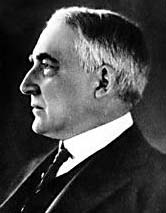 |
| President Harding |
Background: Warren Harding came out of nowhere to seize the 1920
Republican Presidential nomination and go on to win the election.
Almost from the outset, his administration was plagued with scandal.
Harding installed several of his old Ohio friends in important positions
within his Cabinet, and his White House was known more for its poker
games and evening burlesques than for any actual legislation. The
mid-term congressional elections of 1922, in which Republican candidates
got hammered, were a wake-up call for Harding, who said of his friends,
"they're the ones that keep me walking the floors at night." In a June
1923 speech, Harding vowed to rid his administration of corruption.
But before doing so, the President had to make a long-promised trip west
with his wife Florence and his good friend Jess Smith, assistant to the
U.S. Attorney General.
Shortly before he left, the President received information that someone
in the Justice Department was receiving kickbacks from Chicago gangster
Al Capone's organization in order to protect Capone's monopoly on
bootlegging (the United States had been "dry" since Prohibition began in
1919). Harding discussed the matter with Jess Smith, and both men
endeavored to launch a full investigation when they returned to
Washington.
Harding's historic trip west was beset by problems. A ship taking the
President up the Alaska coast ran aground, then the President became
sick with food poisoning after dining on some local crabs. On July 30,
1923, as the ship set sail from Alaska to San Francisco for the last leg
of the trip, President Harding was eager to get back to Washington and
commence a new, corruption-free chapter in his presidency.
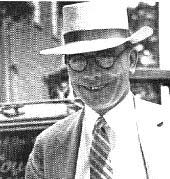 |
| Franklin Prevost |
Incident: On the night of August 1, Franklin Prevost, Director of
the FVZA office in San Francisco, received an urgent call from Jess
Smith asking him to meet the Presidential boat as it steamed into the
harbor. Prevost, an ambitious, idealistic young man who had risen to
become the youngest regional director in the Agency's history, boarded
the boat on a typically foggy San Francisco evening and was informed by
Smith that President Harding had been bitten by a vampire some time the
previous evening. Smith told Prevost that one of the ship's hands, a
Norwegian named Olaf Johans, had done it, and that he had leaped
overboard after the attack. Prevost entered the Presidential Suite and
found Harding in a vampiric coma, the telltale puncture wounds on his
neck, his wife Florence at his bedside. A brief discussion arrived at
the only reasonable course of action, and the President was put out of
his misery with a dose of cyanide.
Both Smith and Florence Harding wanted to keep the true means of the
President's demise a secret. Prevost was hesitant, but eventually
agreed to keep quiet and so, on August 2, 1923, it was announced that
President Harding had died of food poisoning while on his way to San
Francisco. No further investigation was ever conducted, as Florence
Harding would not allow an autopsy on her husband. The body was
returned to Washington for burial, and for the first and only time in
American history, an FVZA report was suppressed.
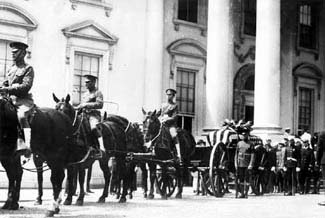 |
| President Harding's Funeral |
The official version of death by poisoning did little to quell rumors
flying around Washington and the rest of the country. Why hadn't Mrs.
Harding permitted an autopsy, and why was there such a hasty burial? If
Warren Harding had been murdered, then there were no shortage of
suspects. Harding's promise to wipe out corruption would likely mean
jail time for some of his pals. Even Harding's wife, Florence, came
under suspicion, as the President's many affairs had caused her great
personal anguish and embarrassment.
Investigation: The rumors and suspicions eventually died down as
Vermonter Calvin Coolidge assumed the reins of government. But across
the country in San Francisco, several unanswered questions continued to
nag at FVZA Director Prevost. How had a man bitten by a vampire been
able to board a ship carrying the President? And how had that vampire
gotten to Harding, who was under full Secret Service protection?
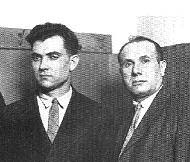 |
Capone hit men
Scalise and Anselmi |
Prevost quietly began his own investigation, interviewing everyone who
had been on or around the ship in the days leading up to Harding's
death. He learned that the Norwegian shiphand had disappeared two days
before the ship's departure from Alaska. A big break came when a
witness identified John Scalise and Albert Anselmi, two thugs from the
Al Capone crime organization, as leaving the ship the night before
Harding was bitten. Prevost began to consider the possibility that
Capone had put a hit on the President to preserve his bootlegging
operation. But the means of the hit-murder by vampire-didn't match
gangster modus operandi. And it still didn't explain how the vampire
had gotten to the President.
Then came a stunning announcement from Washington: former Assistant
Attorney General Jess Smith had been indicted for accepting bribes from
Al Capone. For Prevost, Smith's link to Capone seemed to solve the
puzzle of Harding's death. During the trip west, Smith had enjoyed
unfettered access to the President, and stood to lose much in Harding's
promised purge of corruption. In addition, as assistant head of the
Justice Department, Smith had access to the FVZA lab, from which several
vials of vampire blood had gone missing shortly before President
Harding's trip west. Prevost told FVZA Director Hilton Dickerson of his
findings; Dickerson summoned him to Washington, and told to bring along
his report.
Prevost left San Francisco for Washington on September 12, 1924, but he
never reached his destination. As he stepped off the train in St.
Louis, two men with tommy guns burst into the station and opened fire.
Prevost was shot 12 times, and died a short time later at a nearby
hospital. His report was never recovered.
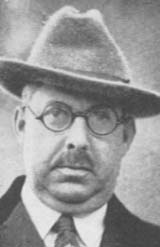 |
| Jess Smith: Assassin? |
Eyewitness accounts of Prevost's murderers matched descriptions of
Capone hit men Scalise and Anselmi. But before police could question
the two men, they turned up dead, riddled with shotgun blasts in a
Chicago barbershop.
Post-Mortems: Although Prevost's file was gone, he left behind
enough information in his San Francisco office to build a case against
Jess Smith in the death of Harding. FVZA Director Hilton Dickerson had
every intention of pursuing the case, until Smith himself wound up dead
from an apparently self-inflicted gunshot wound (the gun was found in
his right hand, but the bullet wound was in his left temple). Smith's
death meant that, only two years after Harding's death, virtually
everyone involved in the event was gone (Florence Harding died November
21, 1924). Only Al Capone remained, and he wasn't talking. The Harding
assassination case was dropped, and Capone continued to prosper until
he was jailed for tax evasion in 1931. Afflicted with syphilis, he died
in Florida in 1947.
Comments from Dr. Pecos: Is it possible that Warren Harding's
close friend and Assistant Attorney General Jess Smith arranged and
helped carry out the murder of the President? The evidence is certainly
compelling. Unfortunately, we will never know the truth, and Harding's
cause of death is still officially listed as a stroke. For Franklin
Prevost, a man accustomed to battling the undead, the fight against
organized crime was played out under a different set of rules. Though
he paid for it with his life, Franklin Prevost's courage stands as a
proud chapter in FVZA history.






No comments:
Post a Comment